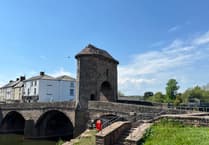Monmouthshire planning officers are recommending approval for the building of two semi-detached houses on ex-railway line land behind Park Crescent in Abergavenny despite fierce opposition from local residents.
Both properties would be reached by a lane that runs to the rear of an existing property (No 61 Park Crescent) which already provides access to several garage plots and a car park owned by Monmouthshire Housing Association (MHA).
But the lane also crosses a footpath linking Park Crescent and Ysguborwen, used on a daily basis by hundreds of pedestrians.
A petition signed by 67 people raises concerns about the potential risk to the public of ‘sharing’ that access with construction traffic and private cars.
Monmouthshire County Council’s planning committee, which meets next Tuesday, has also received six representations raising a number of additional objections.
These include issues about over-development of the site, the development being out of character with the area, its visual impact and concerns that site workers along with neighbours and people using the footpath will come into contact with contaminated soil and waste.
Local residents fear that, if the application is granted, established residential areas of Abergavenny could be blighted by a rush of planning applications for housing that is not appropriate to the area.
MCC granted outline planning permission to the applicant in May. The original plans have since been revised.
Park Crescent resident Yvonne Spencer carried out a mini-survey earlier this year which found that 154 people used the footpath between 8am and 9am in just one day – and a further 140 between 3pm and 4pm including schoolchildren wearing headphones, some on bikes, some on skateboards or scooters, mothers with prams, elderly people, wheelchair users and one woman with a guide dog.
“It’s a very popular and well-used pedestrian access to and from nearby schools, down to Bailey Park and into town, Hundreds of people use it every day and no-one would expect to meet cars there,” she said.
She added that when she conducted the survey she didn’t see any vehicles using the lane either in the morning or afternoon and residents allocated garages there told her they didn’t use them because the point where the access to the new properties is planned was so narrow.
One signatory to the petition says: “As a parent of two children who regularly use the footpath to go to King Henry,
“I fully endorse the comments regarding increased danger from the vehicular access to the proposed properties.”
Another Park Crescent resident Sian Domi pointed out in a written statement to the planning committee in May that there was a blind spot opposite the access point which meant pedestrians would not see vehicles emerging from or entering the lane and that approval of the plans would result in up to eight cars driving across a busy public path used for access to three schools and a nursery and to access the town, park and a large housing estate.
Among other things she also objected to the additional development of a plot that was intended, historically, for one dwelling.
Yvonne and Sian and other local residents say they’re ‘disgusted’ that no-one seems to be listening to or prepared to discuss their concerns.
MCC planning officer Kate Bingham, in her report to the committee, says the access off Ysguborwen already serves six garage plots and at least two further dwellings and that ‘this shared surfaced highway has been used as such for many years without recorded incidents’.
She adds that the point of access, with its proposed fencing replacing the hedge, will actually be safer for existing vehicle users and pedestrians.
She says that vehicles accessing the additional dwellings would not significantly increase the overall volume of traffic and would not therefore adversely affect highway safety or the safety of pedestrians using the footpath.
Addressing other concerns she says that the site is within the development boundary of Abergavenny where ‘new residential development is acceptable in principle’.
The proposed properties are ‘broadly in keeping’ with the surrounding dwellings and would not adversely affect the character or appearance of the area.
She argues there would be ‘a reasonable amount of space around the proposed dwellings for circulation, parking and amenity purposes’ and that the proposal is not considered to be an over development of the site.
She acknowledges that the applicant may have to obtain consent from MHA to gain vehicular access over the lane but stresses that ‘this is a private legal matter and not a material planning consideration’.
Regarding the issue of contaminated land the applicant, she says, has started the site investigation/risk assessment procedure by submitting a Geo-Environmental report.
Sampling has identified elevated levels of lead and zinc, but proposed remediation – by capping the site with buildings, hard-standing and 600mm of clean cover – would be suitable, provided the imported material met the required standards.
A verification/validation report will also have to be submitted to show the suitability of the imported material and the depth of capping achieved.
Any groundwork undertaken on site must be properly controlled to protect the health, safety and welfare of onsite workers and neighbours from dust inhalation and contact with contaminated soil.
She concludes, “The council’s specialist environmental health officer has not raised any concerns about neighbours or members of the public who would be using the adjacent footpath being at any risk from dermal, inhalation or ingestion of contaminated soil or waste from the site.
“It is therefore reasonable to assume that this is not an issue.”




